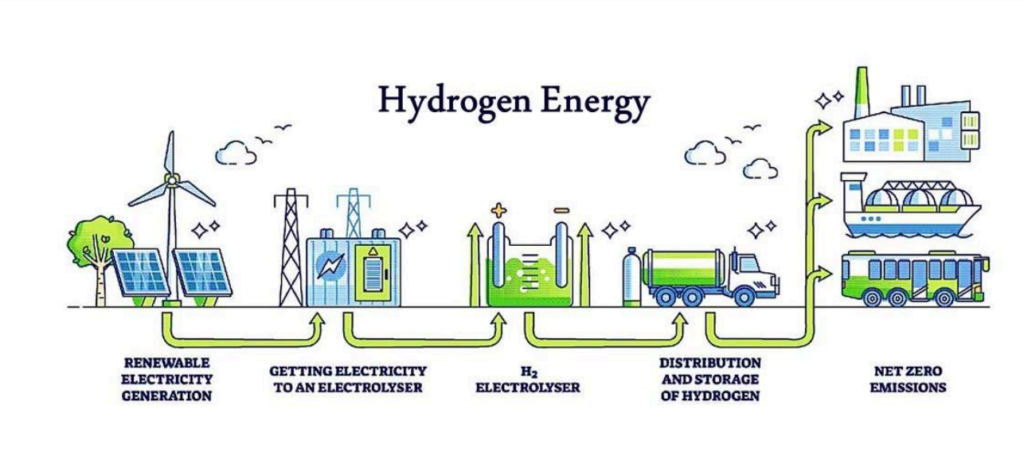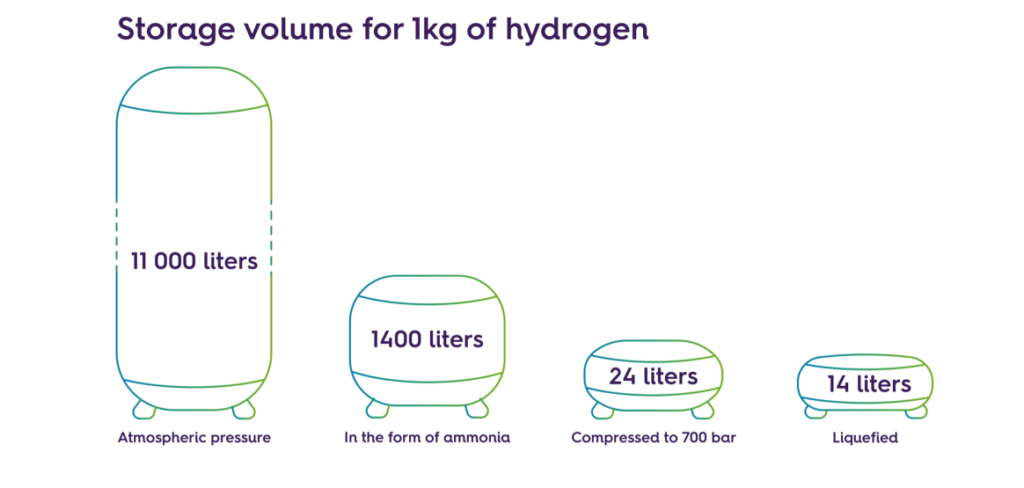Hydrogen as an Energy Source for the Future?
Hydrogen has long been touted as a promising alternative energy source, with the potential to power everything from cars to homes. But is it really the future of energy? Many experts believe that hydrogen could be a key player in the transition to a low-carbon economy, but there are also significant challenges that must be overcome.

One of the main advantages of hydrogen is that it is a clean-burning fuel. When hydrogen is burned, the only byproduct is water, making it an attractive option for reducing greenhouse gas emissions. Additionally, hydrogen can be produced using renewable energy sources such as wind and solar power, further reducing its environmental impact. However, the production, storage, and transportation of hydrogen all come with their own unique challenges, which must be addressed in order to make it a viable energy source.
Despite these challenges, many countries and companies are investing in hydrogen technology, with the hope of creating a more sustainable future. With the right infrastructure and policies in place, hydrogen could play a major role in reducing our reliance on fossil fuels. However, it remains to be seen whether hydrogen will truly be the energy source of the future.
Hydrogen Fundamentals
Is hydrogen the clean fuel of the future?
Chemical Properties
Hydrogen is a chemical element with the symbol H and atomic number 1. It is the lightest and most abundant element in the universe, making up about 75% of its elemental mass. Hydrogen gas is colourless, odourless, tasteless, and non-toxic. It is also highly flammable and can ignite spontaneously in air.
Hydrogen has many unique chemical properties that make it an attractive energy source. It has a high energy content per unit of weight, which means that it can store a lot of energy in a small space. It also burns cleanly, producing only water vapour as a by-product. This makes it an ideal fuel for transportation and other applications where emissions are a concern.
Production Methods
Production Methods Hydrogen can be produced from a variety of sources, including fossil fuels, biomass, and water. The most common method of production is steam methane reforming, which involves reacting natural gas with steam to produce hydrogen and carbon dioxide.
Other methods of production include electrolysis, which involves splitting water into hydrogen and oxygen using an electric current, and biomass gasification, which involves heating organic matter in the absence of oxygen to produce a gas that can be converted into hydrogen.
Each method of production has its own advantages and disadvantages in terms of cost, efficiency, and environmental impact. As research continues, it is likely that new and more efficient methods of production will be developed, making hydrogen an even more attractive energy source for the future.
Current Energy Landscape
What Is Green Hydrogen And Will It Power The Future?
Fossil Fuels Dependency
The world is heavily dependent on fossil fuels such as coal, oil, and gas for its energy needs. These fuels are finite resources and their extraction and consumption have significant environmental impacts. The burning of fossil fuels
releases greenhouse gases, which contribute to climate change and air pollution. Moreover, the demand for fossil fuels has led to geopolitical tensions and conflicts in some regions of the world.
Despite these concerns, the use of fossil fuels is still widespread, especially in developing countries where access to energy is limited. In 2019, fossil fuels accounted for approximately 84% of the world’s primary energy consumption,
according to the International Energy Agency.
Renewable Energy Sources
In recent years, there has been a growing interest in renewable energy sources, such as solar, wind, and hydropower. These sources are considered cleaner and more sustainable than fossil fuels, and their costs have been declining rapidly. In 2020, renewable energy accounted for around 11% of the world’s primary energy consumption, according to the International Renewable Energy Agency.
While renewable energy has made significant progress, it still faces challenges such as intermittency, storage, and grid integration. Moreover, the transition to renewable energy requires significant investments in infrastructure and
technology, which may not be feasible for all countries.
Overall, the current energy landscape is characterised by a mix of fossil fuels and renewable energy sources. The future of energy will depend on how countries balance their energy needs with their environmental and economic goals.
Hydrogen as an Energy Carrier
Hydrogen is a versatile energy carrier that can be produced from various sources, including natural gas, biomass, and water. It has the potential to play a significant role in the transition to a low-carbon energy system, as it produces no greenhouse gases when used in fuel cells or combustion engines. This section explores the storage and transport, efficiency and conversion of hydrogen as an energy carrier.

Storage and Transport
One of the challenges of using hydrogen as an energy carrier is its low density, which makes it difficult to store and transport. To overcome this challenge, hydrogen can be compressed or liquefied. Compressed hydrogen is stored at high pressure in tanks, while liquefied hydrogen is stored at very low temperatures in insulated tanks. Both methods require specialized infrastructure, but they offer different advantages and disadvantages in terms of cost, safety, and energy efficiency.

Efficiency and Conversion
The efficiency of using hydrogen as an energy carrier depends on the conversion process used to produce and use it. The most common methods of producing hydrogen are steam methane reforming and electrolysis. Steam methane
reforming is a mature technology that uses natural gas as a feedstock, while electrolysis uses electricity to split water into hydrogen and oxygen. Both methods have different energy and environmental impacts, and their efficiency
depends on the source of the feedstock and electricity.
The efficiency of using hydrogen as a fuel also depends on the conversion process used. Hydrogen can be used in fuel cells, which convert the chemical energy of hydrogen and oxygen into electrical energy and water, or in combustion engines which burn hydrogen to produce heat and mechanical energy. Fuel cells offer higher efficiency and lower emissions than combustion engines, but they require expensive materials and infrastructure.
In conclusion, hydrogen has the potential to be an important energy carrier in the transition to a low-carbon energy system. However, its storage and transport, efficiency and conversion depend on the methods used, which have different advantages and disadvantages.
Environmental Impact
Emission Reduction Potential
Hydrogen as an energy source has the potential to significantly reduce greenhouse gas emissions. When hydrogen is burned, the only byproduct is water, making it a clean energy source. Hydrogen can be produced from a variety
of sources, including renewable sources such as wind and solar power. This means that hydrogen has the potential to be a zero-emission energy source.
However, it is important to note that the production of hydrogen can still result in emissions if fossil fuels are used in the process. The carbon emissions from the production of hydrogen can be reduced by using carbon capture and storage technology.

Sustainability Challenges
While hydrogen has the potential to be a clean energy source, there are sustainability challenges that need to be addressed. One of the main challenges is the production of hydrogen itself. Currently, most hydrogen is produced using fossil fuels, which results in carbon emissions.
To make hydrogen a sustainable energy source, it is important to shift towards renewable sources of hydrogen production. This can be achieved by using renewable energy sources such as wind and solar power to produce hydrogen through electrolysis.
Another sustainability challenge is the storage and transportation of hydrogen. Hydrogen is a highly flammable gas, which requires special storage and transportation methods. The infrastructure required for the storage and transportation of hydrogen is currently limited, making it difficult to scale up the use of hydrogen as an energy source.
Overall, while hydrogen has the potential to be a clean and sustainable energy source, there are still challenges that need to be addressed before it can become a mainstream energy source.
Economic Considerations
Infrastructure Costs
One of the biggest challenges to implementing hydrogen as an energy source is the high infrastructure costs. This includes the cost of building and maintaining the necessary production, storage, and transportation facilities. The production of hydrogen requires large amounts of electricity, which can be expensive, and the transportation of hydrogen requires special pipelines or trucks.
However, as technology advances and economies of scale are achieved, the costs of infrastructure are expected to decrease. Governments and private companies are investing in research and development to make hydrogen more affordable and accessible.
Market Viability
Another economic consideration is the market viability of hydrogen as an energy source. Currently, hydrogen is more expensive than traditional fossil fuels such as oil and gas. However, as the world shifts towards renewable energy sources, the demand for hydrogen is expected to increase.
Hydrogen has the potential to be used in a variety of industries, including transportation, power generation, and heating. The transportation sector, in particular, is seen as a promising market for hydrogen fuel cells. Companies such as Toyota, Honda, and Hyundai are already producing hydrogen-powered vehicles, and governments around the world are investing in infrastructure to support these vehicles.
Overall, while there are economic challenges to implementing hydrogen as an energy source, the potential benefits make it a promising option for the future. As technology advances and economies of scale are achieved, the costs of
infrastructure are expected to decrease, and the market viability of hydrogen is expected to increase.
-
 The SignatureSPM, Revolutionising Multimodal Characterization for Academic and Industrial Laboratories
The SignatureSPM, Revolutionising Multimodal Characterization for Academic and Industrial Laboratories -
 FANDA Scientific Partners with GoyaLab to Bring Spectrometry Expertise to the MENA Region
FANDA Scientific Partners with GoyaLab to Bring Spectrometry Expertise to the MENA Region -
 Hydrogen as an Energy Source for the Future?
Hydrogen as an Energy Source for the Future? -
 History of Spectroscopy in the Middle East: From Ancient Times to Modern Applications
History of Spectroscopy in the Middle East: From Ancient Times to Modern Applications






